Driving Safety
Share the Road
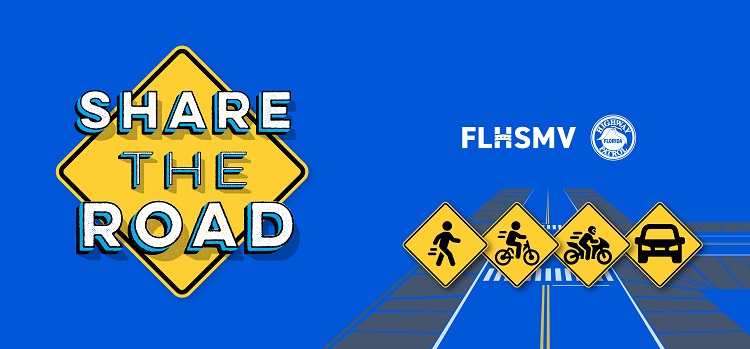
Motorists, bicyclists, and motorcyclists all have the right to be on the road and travel safely. All motorists should use extra caution when driving around bicyclists, motorcyclists and commercial motor vehicles (CMV). The Florida Department of Highway Safety and Motor Vehicles reminds everyone that when we’re on the road together, safety is a shared responsibility – Share the Road, so all road users can Arrive Alive!
Vulnerable Road Users
According to Florida Statute 316.027(1)(b), a “vulnerable road user” means:
- A pedestrian who is working on a highway, utility facilities along a highway, or providing emergency services within the right-of-way.
- A person operating a bicycle, electric bicycle, motorcycle, scooter, or moped lawfully on the roadway.
- A person riding an animal.
- A person lawfully operating on a public right-of-way, crosswalk, or shoulder of the roadway, which includes: a. A farm tractor or similar vehicle designed primarily for farm use;
- A skateboard, roller skates, or in-line skates;
- A horse-drawn carriage;
- An electric personal assistive mobility device; or
- A wheelchair.
-
Recent changes to bicycle laws - Effective 7/1/21:
Ch. 180 “Bicycle and Pedestrian Safety” (SB 950 – Book)
Florida Statutes, Chapters: 212, 316, 322, 655- The bill provides that no-passing zones do not apply to drivers who safely and briefly drive to the left of center of the roadway to overtake a bicycle, other nonmotorized vehicle, an electric bicycle, or a pedestrian.
- The bill requires a vehicle making a right turn while overtaking and passing a bicycle proceeding in the same direction, to do so only if the bicycle is at least 20 feet from the intersection.
- The bill authorizes bicyclists riding in groups, after coming to a full stop, to go through an intersection in groups of 10 or fewer, and provides guidelines for riding a bicycle in a substandard-width lane and authorizes riders to ride two abreast if certain conditions exit.
Bicycle Safety Awareness
In Florida, the bicycle is legally defined as a vehicle and has all of the privileges, rights and responsibilities on public roads (except for expressways) that a motor vehicle operator does.
Bicyclists may ride out of the bike lane in the travel lane for their own safety on narrow roads to avoid obstacles or pavement hazards, or to prepare for a left turn. A bicyclist may use the full lane even while traveling substantially below the speed of traffic if the lane is too narrow for both a car and bicycle to share.
To learn more about laws and safety rules for bicyclists, see pages 40 and 41 in the Florida Driver License Handbook.
Rules for Bicyclists
- Obey all traffic controls and signals.
- Do not ride a bicycle under the influence of alcohol or drugs.
- Stay alert – do not text while biking or wear headphones or ear buds so you can hear everything around you.
- If you are not traveling at the speed of other traffic, you must use the bike lane, and if no bike lane is available, you must stay on the right-most side of the road.
- You may use the full lane when making a left turn, passing, avoiding hazards, or when a lane is too narrow for you and a car to share it safely.
- Use directional hand signals to show other drivers that you are about to turn.
- Never attach yourself or your bike to any vehicle on the roadway.
- If you are riding on a sidewalk or crosswalk, you have all the rights and duties as a pedestrian. However, you must yield the right-of-way to pedestrians.
- Between sunset and sunrise, you must have a white light visible from 500 feet on the front of your bicycle and a red reflector and a red light visible from 600 feet on the rear. Be seen – wear neon or fluorescent colors and wear something reflective when riding at any time during the day.
- All bicyclists and passengers under age 16 are required to wear helmets. However, it is recommended that all bicycle riders wear a helmet, no matter your age.
- When riding with others, you may not ride more than two side-by-side unless it is part of a roadway reserved for bicycles; you must ride single file if you and the other rider are impeding traffic.
Tips for Motorists
- Drivers must give bicyclists a minimum of three feet of clearance when driving alongside or passing them. It’s the law.
- When turning, yield to any bicyclist in the bike lane and make your turn behind the cyclist.
- Avoid using high beam headlights when you see a bicyclist approaching.
- Before opening a car door, check for bicyclists who may be approaching from behind.
Commercial Motor Vehicle Awareness
Commercial motor vehicles (CMV), including large trucks and buses, have operating limitations such as large blind spots, long stopping distances, and limited maneuverability that make it essential for other road users to put extra focus on safety. Take action to avoid problems and crashes involving CMVs by following the tips below:
Tips for Motorists
- Motorists are encouraged to stay out of the “No Zone” areas. Commercial motor vehicles have large blind spots in front, behind, and on both sides of the vehicle; this is known as the “No Zone.” Even though large vehicles have several rear-view mirrors, other vehicles will be hidden from view if within the “No Zone” or blind spot.
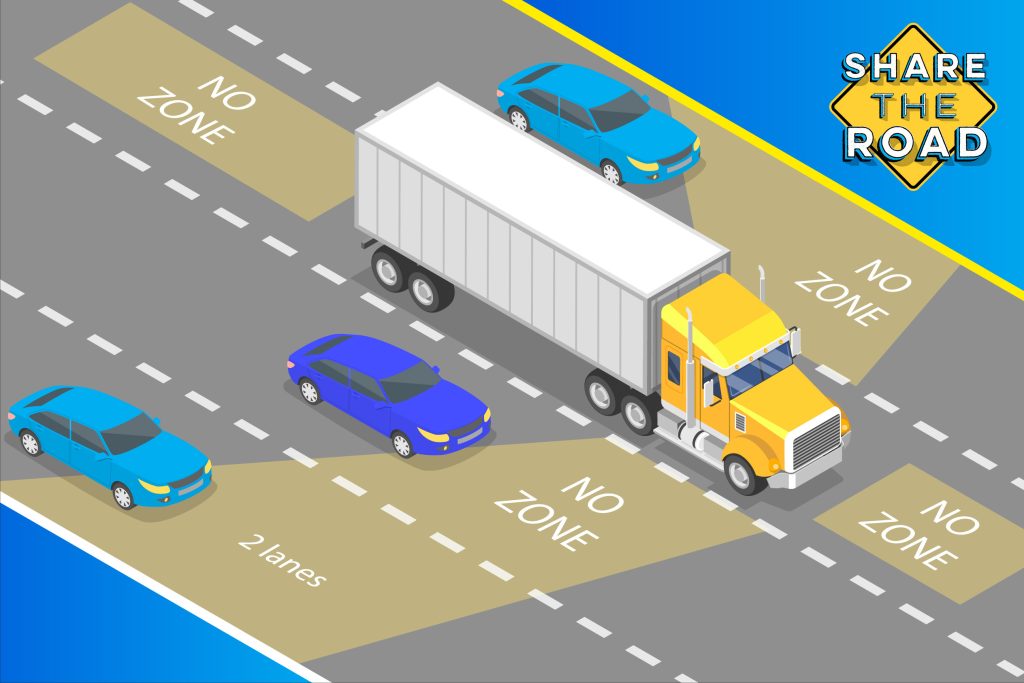
- Do not tailgate; you’ll be in the rear blind spot and may collide with the truck if it stops unexpectedly.
- If you are stopped behind a truck on an upgrade, leave space in case the truck drifts back when it starts to move. Also, keep to the left in your lane so the driver can see that you’re stopped behind the truck.
- Do not use high beam headlights when you are following a truck at night. Bright lights will blind the driver when they reflect off the truck’s large side mirrors.
- When you meet a truck coming from the opposite direction, keep to the right to avoid a sideswipe crash.
- Commercial motor vehicles often need to swing wide to the left in order make a right turn. Do not drive between the commercial vehicle and the curb—they will not be able to see you.
- Never cross behind a truck that is preparing to back up or is in the process of doing so. Remember, the size of most trucks and trailers completely hide objects behind them from view.
- Pass trucks on the left side for maximum visibility. Avoid cutting in too soon when passing a truck. Large vehicles cannot stop as quickly as other vehicles. Never linger besides a large truck or bus.
- When a truck passes you, keep to the right side of your lane. Do not speed up while the truck is passing you.
- Visit Florida’s Pedestrian & Bicycle Focused Initiative for more information developed specifically for drivers of commercial motor vehicles.
Motorcycle Safety Awareness
Motorcycle and moped drivers have the same rights and duties as drivers of motor vehicles. Learn more about motorcycle rules and responsibilities by downloading the Florida Motorcycle Handbook. Learn more about approved motorcycle safety courses, motorcycle endorsements or Motorcycle Only licenses, by visiting the Florida Rider Training Program.
Rules for Motorcyclists
- Under Florida law, motorcyclists must wear eye protection and U.S. Department of Transportation-compliant protective head gear or helmet. Motorcyclists over the age of 21 can only ride or operate a motorcycle without a helmet if they have proper insurance coverage.
- To obtain a motorcycle endorsement on their driver license or a Motorcycle Only license, motorcyclists must complete an approved motorcycle safety course.
- Motorcycles and mopeds may not be operated on bicycle paths or foot paths.
Tips for Motorists
- Never attempt to share the lane with a motorcycle. The motorcyclist is entitled to the entire lane.
- Watch for motorcycles and look carefully before pulling into an intersection or changing lanes.
- It is difficult to gauge the speed of a motorcycle; they may appear to be much farther away than they really are.
- Do not follow too closely behind a motorcycle; motorcycles have the ability to stop more quickly than other vehicles.
- Motorcyclists often slow down by down-shifting or rolling off the throttle, thus not activating the brake light.
- Never pass a motorcyclist with only a few feet of space. The force of the wind gust can cause the rider to lose control.
- When being passed by a motorcycle, maintain your lane position and do not increase your speed.
- Maintain a four-second buffer zone between you and a motorcyclist, and increase space when encountering inclement weather, gusty winds, wet or icy roads, bad road conditions and railroad crossings.
Pedestrian Safety
Pedestrians have the highest fatality rate among all road users in Florida, according to FLHSMV data. They usually use sidewalks, crosswalks, and intersections to interact with motorists, bicyclists, motorcycles, and commercial vehicles.
- In 2023, pedestrians were involved in over 10,200 crashes in Florida, with over 779 deaths and over 1,431 serious bodily injuries.
- Crashes involving pedestrians most commonly occur between 6 p.m. and 9 p.m. when people enjoy Florida’s outdoors.
- 85% of pedestrian fatalities occur during the early morning, late afternoon, and evening.
- Walk on sidewalks whenever they are available. If one isn’t available, walk facing traffic and as far from traffic as possible.
- Pay attention and keep alert at all times. Avoid wearing headphones so that you can hear the traffic and pedestrians around you. Never text or look at your cell phone when crossing the street.
- Whenever possible, cross streets at crosswalks or intersections, where drivers expect pedestrians, and look for cars in all directions, including those turning. If neither are available, locate a well-lit area where you have the best view of traffic. Wait for a gap in traffic that allows enough time to cross safely and watch for traffic as you cross.
- Never enter the street from between parked cars. If crossing mid-block cannot be avoided, pedestrians must yield right of way to vehicles on the roadway.
- Do not cross an intersection diagonally except where and when crossing is authorized by official traffic control devices.
- Watch for cars entering or exiting driveways or backing up in parking lots.
- Be visible at all times. Wear bright clothing during the day and wear reflective materials or use a flashlight at night. Never assume a driver sees you. Make eye contact with drivers as they approach to make sure you are seen.
Learn More
Resources
Data Dashboard
Social Media Kit
Print Media Kit



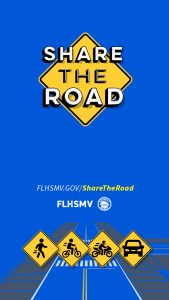
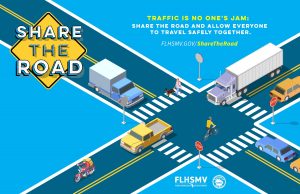
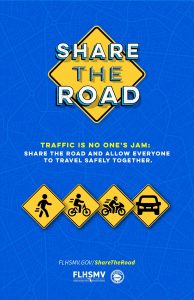
Dave Kerner, Executive Director